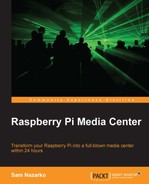Book Description
Turn your Raspberry Pi into a full-blown media center using Raspbmc. This guide has all the plain language instructions you need to control your TV with a smartphone and create your own media library. No special skills required.
- Discover how you can stream video, music, and photos straight to your TV
- Play existing content from your computer or USB drive
- Watch and record TV via satellite, cable, or terrestrial
- Build your very own library that automatically includes detailed information and cover material
In Detail
Low-cost and high-performing, with a massively diverse range of uses and applications, the Raspberry Pi is set to revolutionize the way we think about computing and programming. Using it as a Media Center allows everyone to have a low-cost device that is always on, attached to their TV.
Imagine controlling your TV with your smartphone, dynamically streaming content that you have on various devices across your home, as and when you want. Raspberry Pi Media Center will show you how to configure the complete experience using readily available and accessible tools, so that you too will soon be enjoying your media from the comfort of your own sofa.
With this practical guide, you’ll discover how you can transform your Raspberry Pi into a powerful media center. Using Raspbmc (based on the XBMC distribution), you'll be shown how you can deploy and configure your own media center, including coverage of all the essentials from controlling your device with a TV remote or smartphone, to the creation and customization of your very own media library (including the conversion of any existing collection). You'll even be able to stream multimedia from your devices or directly from the Internet!
Table of Contents
- Raspberry Pi Media Center
- Table of Contents
- Raspberry Pi Media Center
- Credits
- About the Author
- About the Reviewers
- www.PacktPub.com
- Preface
- 1. Getting Started
- 2. Using Raspbmc
- 3. Managing Content
- 4. Streaming from a Computer
- 5. Setting up the Library Mode
- 6. Using PVR with Raspbmc
- 7. Converting Media
- A. Useful Raspbmc Commands
- B. Useful MySQL Commands
- C. Supported Peripherals
- Index
